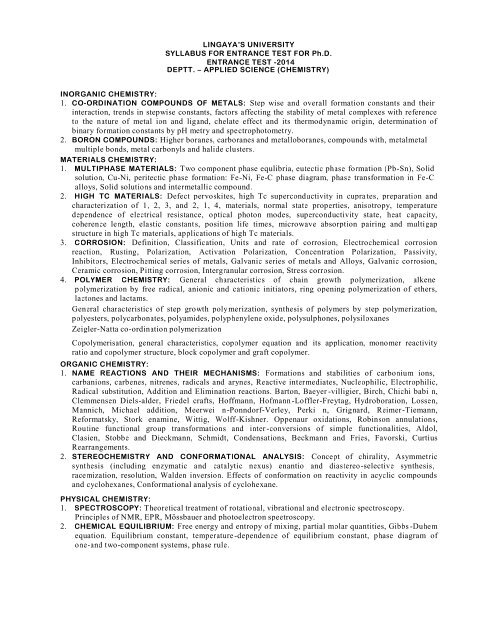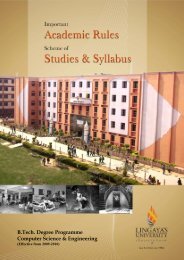1. COMPUTER ARCHITECTURE & ORGANIZATION: Combinational ...
1. COMPUTER ARCHITECTURE & ORGANIZATION: Combinational ...
1. COMPUTER ARCHITECTURE & ORGANIZATION: Combinational ...
You also want an ePaper? Increase the reach of your titles
YUMPU automatically turns print PDFs into web optimized ePapers that Google loves.
LINGAYA’S UNIVERSITYSYLLABUS FOR ENTRANCE TEST FOR Ph.D.ENTRANCE TEST -2014DEPTT. – APPLIED SCIENCE (CHEMISTRY)INORGANIC CHEMISTRY:<strong>1.</strong> CO-ORDINATION COMPOUNDS OF METALS: Step wise and overall formation constants and theirinteraction, trends in stepwise constants, factors affecting the stability of metal complexes with referenceto the nature of metal ion and ligand, chelate effect and its thermodynamic origin, determination ofbinary formation constants by pH metry and spectrophotometry.2. BORON COMPOUNDS: Higher boranes, carboranes and metalloboranes, compounds with, metalmetalmultiple bonds, metal carbonyls and halide clusters.MATERIALS CHEMISTRY:<strong>1.</strong> MULTIPHASE MATERIALS: Two component phase equlibria, eutectic phase formation (Pb-Sn), Solidsolution, Cu-Ni, peritectic phase formation: Fe-Ni, Fe-C phase diagram, phase transformation in Fe-Calloys, Solid solutions and intermetallic compound.2. HIGH TC MATERIALS: Defect pervoskites, high Tc superconductivity in cupra tes, preparation andcharacterization of 1, 2, 3, and 2, 1, 4, materials, normal state properties, anisotropy, temperaturedependence of electrical resistance, optical photon modes, superconductivity state, heat capacity,coherence length, elastic constants, position life times, microwave absorption pairing and multigapstructure in high Tc materials, applications of high Tc materials.3. CORROSION: Definition, Classification, Units and rate of corrosion, Electrochemical corrosionreaction, Rusting, Polarization, Activation Polarization, Concentration Polarization, Passivity,Inhibitors, Electrochemical series of metals, Galvanic series of metals and Alloys, Galvanic corrosion,Ceramic corrosion, Pitting corrosion, Intergranular corrosion, Stress corrosion.4. POLYMER CHEMISTRY: General characteristics of chain growth polymerization, alkenepolymerization by free radical, anionic and cationic initiators, ring opening polymerization of ethers,lactones and lactams.General characteristics of step growth polymerization, synthesis of polymers by step polymerization,polyesters, polycarbonates, polyamides, polyphenylene oxide, polysulphones, polysiloxanesZeigler-Natta co-ordination polymerizationCopolymerisation, general characteristics, copolymer equation and its application, monomer reactivityratio and copolymer structure, block copolymer and graft copolymer.ORGANIC CHEMISTRY:<strong>1.</strong> NAME REACTIONS AND THEIR MECHANISMS: Formations and stabilities of carbonium ions,carbanions, carbenes, nitrenes, radicals and arynes, Reactive intermediates, Nucleophilic, Electrophilic,Radical substitution, Addition and Elimination reactions. Barton, Baeyer -villigier, Birch, Chichi babi n,Clemmensen Diels-alder, Friedel crafts, Hoffmann, Hofmann -Loffler-Freytag, Hydroboration, Lossen,Mannich, Michael addition, Meerwei n-Ponndorf-Verley, Perki n, Grignard, Reimer-Tiemann,Reformatsky, Stork enamine, Wittig, Wolff-Kishner. Oppenaur oxidations, Robinson annulations,Routine functional group transformations and inter -conversions of simple functionalities, Aldol,Clasien, Stobbe and Dieckmann, Schmidt, Condensations, Beckmann and Fries, Favorski, CurtiusRearrangements.2. STEREOCHEMISTRY AND CONFORMATIONAL ANALYSIS: Concept of chirality, Asymmetricsynthesis (including enzymatic and catalytic nexus) enantio and diastereo-selective synthesis,racemization, resolution, Walden inversion. Effects of conformation on reactivity in acyclic compoundsand cyclohexanes, Conformational analysis of cyclohexane.PHYSICAL CHEMISTRY:<strong>1.</strong> SPECTROSCOPY: Theoretical treatment of rotational, vibrational and electronic spectroscopy.Principles of NMR, EPR, Mössbauer and photoelectron speetroscopy.2. CHEMICAL EQUILIBRIUM: Free energy and entropy of mixing, partial molar quantities, Gibbs -Duhemequation. Equilibrium constant, temperature -dependence of equilibrium constant, phase diagram ofone-and two-component systems, phase rule.
















